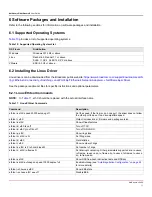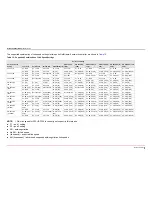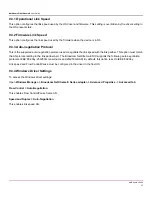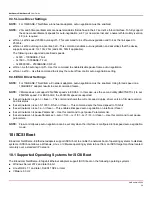
NetXtreme-UG100
31
NetXtreme-C/NetXtreme-E
User Guide
2. Select
ESC
to return to the
Main
menu.
3. From the
Main
menu, select
Initiator Parameters
.
4. From the
Initiator Parameters
screen, enter values for the following:
– IP Address (unspecified IPv4 and IPv6 addresses should be "0.0.0.0" and "::", respectively)
– Subnet Mask Prefix
– Default Gateway
– Primary DNS
– Secondary DNS
– iSCSI Name (corresponds to the iSCSI initiator name to be used by the client system)
NOTE:
Enter the IP address. There is no error-checking performed against the IP address to check for duplicates or
incorrect segment/network assignment.
5. Select
Esc
to return to the
Main
menu.
6. From the
Main
menu, select
1st Target Parameters
.
NOTE:
For the initial setup, configuring a second target is not supported.
7.
From the
1st Target Parameters
screen, enable
Connect
to connect to the iSCSI target. Type values for the following
using the values used when configuring the iSCSI target:
– IP Address
– TCP Port
– Boot LUN
– iSCSI Name
8. Select
Esc
to return to the
Main
menu.
9. Select
Esc
and select
Exit
and
Save Configuration
.
10. Select
F4
to save the MBA configuration.
10.2.4.2 Dynamic iSCSI Boot Configuration
In a dynamic configuration, specify that the system's IP address and target/initiator information are provided by a DHCP
server (see IPv4 and IPv6 configurations in
“Configuring the DHCP Server to Support iSCSI Boot” on page 33
). For IPv4,
with the exception of the initiator iSCSI name, any settings on the Initiator Parameters, 1st Target Parameters, or 2nd Target
Parameters screens are ignored and do not need to be cleared. For IPv6, with the exception of the CHAP ID and Secret,
any settings on the Initiator Parameters, 1st Target Parameters, or 2nd Target Parameters screens are ignored and do not
need to be cleared. For information on configuration options, see
Table 18 on page 29
.
NOTE:
When using a DHCP server, the DNS server entries are overwritten by the values provided by the DHCP server.
This occurs even if the locally provided values are valid and the DHCP server provides no DNS server information.
When the DHCP server provides no DNS server information, both the primary and secondary DNS server values
are set to 0.0.0.0. When the Windows OS takes over, the Microsoft iSCSI initiator retrieves the iSCSI Initiator
parameters and configures the appropriate registries statically. It overwrites whatever is configured. Since the
DHCP daemon runs in the Windows environment as a user process, all TCP/IP parameters have to be statically
configured before the stack comes up in the iSCSI Boot environment.
If DHCP Option 17 is used, the target information is provided by the DHCP server, and the initiator iSCSI name is
retrieved from the value programmed from the Initiator Parameters screen. If no value was selected, then the controller
defaults to the name:
















































